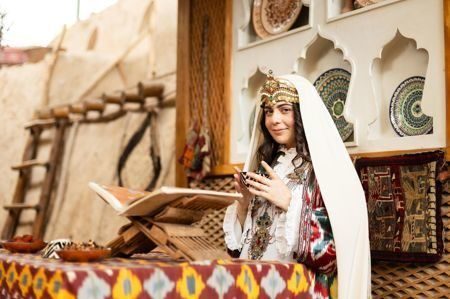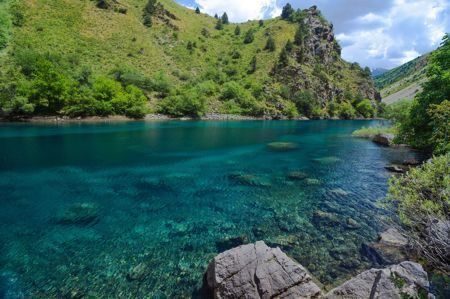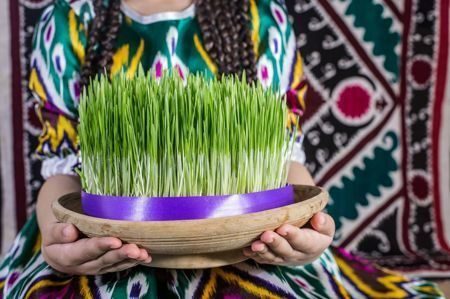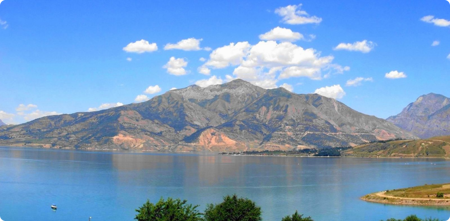Bukhara is one of the most ancient cities of Central Asia. Today Bukhara is more than 2500 years old. This city was once considered sacred and was home to the best craftsmens from all over the East. Arriving in Bukhara, you have the opportunity to jump into the past for several centuries, because every hotel, restaurant or house is an architectural structure of the XVIII-XVII or even XII-XIX centuries, as well as the Ark fortress and the grandeur of the Kalyan minaret, before which even Genghis Khan bowed head, will not leave anyone indifferent.
| Ensemble - Poi Kalyan | |
| The Poi-Kalyan architectural ensemble (in some sources, Poy-Kalyan) stands in the heart of the old city of Bukhara. The name of the complex is translated into Russian as "foot of the great" or "foot of the minaret". Poi-Kalyan dates back to the XII-XIII centuries and is considered the Central architectural ensemble of Bukhara. In the 12th century, Arslan Khan of the Karakhanid dynasty began rebuilding the city and moved the main buildings to a new location. More... | |
| Madrasah - Miri Arab | |
| The Miri Arab madrasah is still used for its intended purpose today. The name literally translates into Russian as "Emir of Arabic". It was built by Ubaydullah Khan for the Sheikh, the spiritual mentor of the Sheibanid dynasty, the leader of the Muslims of Bukhara-Miri Arab of Yemen (Abdullah Yamani). Here, in the second hall, the tombs of the Khan, the Sheikh himself, and other nobles were preserved.the First hall was used for lectures and as a mosque. More... | |
| Madrasah - Abdulaziz Khan | |
| This magnificent structure was built in 1658, that is, almost 200 years later than the famous madrasah of Ugulbek, nevertheless, these two buildings form a single architectural group with each other, completely different in style. The unique skill of the architects of that time is reflected in all its splendor in the external and internal appearance of the religious educational institution named after Abdulaziz Khan. The Peshtak portal, located in the building, is striking in its brightness and size. More... | |
| Madrasah - Ulughbeg | |
| Madrassah of Ulugbek (1417) was built by the best architects of his time - Ismail isfagani and Najmetdin Bukhari. The madrasah is characterized by balance and harmony of forms, combining strict grandeur and simplicity in decoration. It is a large-scale rectangular building with a high portal on the front of the main entrance and a traditional courtyard. An interesting feature of Ulugbek madrasa is that the corridor at the entrance does not lead to the courtyard, as was customary during the construction of the madrasaMore... | |
| Trading domes of Bukhara | |
| In the XVI century, the Sheibanid dynasty came to power in Central Asia. Seizing the pearl of the East - blessed Bukhara, the Sheibanids made it the capital of their state. From this moment begins the rapid flowering of the city, starts mass construction. The domes of covered bazaars built during this period became a symbol of Bukhara and a reflection of its importance on the great Silk Road. These domes, called “Taki", were erected at the intersection of 2-3 busy streets, directing the movement of people, unloading the main highway and organizing trade. More... | |
| Magoki-Attori Mosque | |
| The" Blue mosque " of Magoki-Attari appeared in the X century on the site of a former unknown pagan structure. It owes its unusual name to the centuries-old cultural layer that grew up around it, which is why the mosque went 4.5 meters deep into the earth. Therefore, the locals called it an "underground" mosque or "located in a pit". Many centuries ago, near the mosque, a Bazaar actively flourished, where spices, medicinal tinctures and medicines were sold, and there was also a certain temple of the moon, after which the building was named "Mokh-mosque". More... | |
| Lyabi-Khauz Ensemble | |
| Lyabi-Khauz Ensemble is one of the most famous and popular attractions in the city. Here on the same territory are collected magnificent architectural masterpieces-madrassas and khanaka Nadir Divan-Begi, built in 1622, and Kukeldash madrassas, whose construction dates back to 1568. These beautiful buildings rise along the coast of an artificial reservoir of impressive size (42 by 36 meters). The depth of this reservoir is 5 meters. In literal translation, the name of the ensemble means "the shore of the pool". More... | |
| Nadir Divan-Begi Ensemble | |
| Madrasah, erected in 1622, is located in the east of Lyabi House. From the very beginning, this building was conceived by the Bukhara nobleman as a caravanserai. Having built it at the beginning of the 17th century, the vizier invited the local nobility to the opening. The most honored guest was Imamkuli Khan, who, to everyone’s surprise, proclaimed the new building not a caravanserai, but a madrasah. In order for the building to correspond to the new rank, it needed to be reconstructed and remodeled. More... | |
| Kukeldash Madrassah | |
| One of the most famous sights of Bukhara — Kukeldash madrasa-is conveniently located near the Lyabi-Hauz architectural complex. This educational institution was built in the period from 1568 to 1569. This is the largest Bukhara madrasa in size, as well as one of the largest similar educational institutions throughout Central Asia. The name "Kukeldash" is very common. There is a madrasa of the same name in Tashkent. The name means "Sunny friend" or "Milky brother". More... | |
| Khoja Abdahadik Al Gijduvani Complex | |
| The Khoja Abdahadik al Gijduvani complex is located in the city of Gijduvan (about 50 km North-East of Bukhara). It is formed around the grave of the famous Sufi Shaikh, the founder of an independent school of mysticism in the region of Central Asia, Abdalhalik Ibn Abdaljalil al-Gijduvani (d. in 1180 or 1220). His father was considered an authoritative faqih, bore the honorary nickname Abduljalil and ascended his origin to Imam Malik b. Anas (713-795). More... | |
| Samanids Mausoleum | |
| One of the oldest Bukhara architectural monuments - the mausoleum of the Samanids - was erected on a vast territory, which in past centuries served as the burial place of the deceased. According to historical information, the mausoleum appeared at the end of the X century in the territory of the cemetery. Its construction was led by Ismail Samani, the founder of the famous dynasty, which occupied the throne for more than a century, from 875 to 999 years. It was the last Persian dynasty to rule in Central Asia. More... | |
| Chashma - Ayub Mausoleum | |
| The name of the mausoleum of Chashma-Ayub in Bukhara (and the well of the same name) is translated as “The Source of Job”. In Arabic, Job sounds like Ayub. The place is sacred to three religions. According to legend, even before the construction of the city of Bukhara on this site, the prophet Job came to the settlement. Locals at this moment were dying of thirst. They prayed to God for salvation from the drought. Job, heeding the requests of the suffering people, hit the ground with his staff - and at the place of the impact a well appeared with pure cool water. More... | |
| Bolo-Khauz Complex | |
| ukhara had its own Registan, located opposite the fortress the Ark. Unfortunately, of all the structures on this huge square of Bukhara, only the Bolo-House complex has managed to survive to our time. It was built at the beginning of the XVII century by order of Emir Shahmurad, who at that time was the ruler of Bukhara. The emir sought to prove to the inhabitants of the city that he was an ordinary person. Therefore, he wanted to erect a public mosque on the Registan, which he personally was going to attend every Friday. More... | |
| Ark Fortress | |
| The impregnable fortress of Ark in Bukhara is a real symbol of power and immutability: 4.3 hectares of the internal area represented a city in a city. Own garrison, all necessary communications and layered defense - the Bukhara rulers knew a lot about ensuring their safety. According to the assumptions of historians, the Ark fortress was founded in the 3rd – 4th century BC on the site of the first organized urban settlements. More... | |
| Kosh-Madrasah | |
| The Kosh-Madrasah, which means “double” or “paired” madrasah in Persian, includes a complex of two elegant buildings - Madori Khan Madrasah and Abdullahan Madrasah. These two madrassas form a kosh - the traditional architectural ensemble of Central Asia, consisting of two buildings located on the same axis and facing the facades to each other. The ensemble of these historical buildings was erected in the 16th century, their founder is the then-famous Uzbek khan Abdullahan, belonging to the Sheibanid dynasty. More... | |

| Sightseeing In Tashkent | ||

| Sightseeing in Samarkand | |

| Sightseeing In Fergana Valley | |

| Sightseeing In Khiva | |
|
Itchan-Kala |
|























